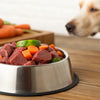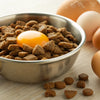How Often Should I Feed My Dog Raw Food: Insights from Pet Care Experts
- Houndsy
Table of Contents
- Introduction
- Understanding Raw Feeding for Dogs
- Feeding Frequency for Different Dog Life Stages
- Transitioning Your Dog to a Raw Food Diet
- Managing Weight Through Feeding
- The Role of the Houndsy Kibble Dispenser in Feeding
- Conclusion
Introduction
Did you know that the dietary needs of dogs can vary significantly based on their age, weight, and activity level? One study shows that more than 30% of dog owners feed their pets raw food, believing it offers numerous health benefits. If you've decided to switch your pup to a raw food diet or are contemplating the change, understanding the right feeding frequency is essential for your dog's health and well-being.
In this guide, we will navigate the complexities of feeding raw food to dogs—specifically addressing the question: how often should I feed my dog raw food? We will cover the crucial factors influencing feeding schedules, weight management considerations, and much more, providing you with the information you need to make informed decisions for your furry friend.
As we explore these subjects, we invite you to reflect on your current feeding routine. Are you meeting your dog's nutritional needs effectively? By the end of this post, you will not only answer the question of frequency but also gain insights into best practices for a healthy raw feeding regimen.
Understanding Raw Feeding for Dogs
What is Raw Dog Food?
Raw dog food typically consists of uncooked meat, bones, organs, and sometimes vegetables and fruits. This approach to feeding aligns closely with what dogs would consume in the wild. It’s a species-appropriate diet that can enhance nutrient absorption, promote healthier skin and coat, support digestive health, and contribute to optimal weight management.
Benefits of Feeding Raw
There are several advantages to feeding dogs raw food, including:
- Improved Digestion: Raw diets are generally easier for dogs to digest, resulting in firmer and smaller stools.
- Nutrient Retention: Raw ingredients maintain their nutrients better than cooked food, ensuring your dog gets the vital vitamins and minerals they require.
- Enhanced Energy Levels: A raw diet supports energy and vitality, crucial for active dogs.
- Healthy Weight Management: A balanced raw diet usually consists of protein and fats that help maintain a healthy weight.
Nutritional Needs of Dogs
Before discussing how often to feed your dog raw food, it’s essential to recognize the nutritional requirements that vary depending on your dog’s:
- Age: Puppies have different needs than adult dogs due to their growth.
- Weight: Appropriate portion sizes are linked closely to ideal body weight.
- Activity Level: More active dogs may require higher calorie intake.
Feeding Frequency for Different Dog Life Stages
Puppies: 2-4 Meals a Day
Puppies have unique dietary needs that demand more frequent feeding schedules. Since they are growing rapidly, feeding them 2-4 times a day is advisable. Here are some key considerations:
- Growth Needs: Puppies generally require more food relative to their weight—about 4-6% of their current body weight daily.
-
Feeding Schedule Examples:
- Four Times a Day: Breakfast, lunch, mid-afternoon, and dinner.
- Three Times a Day: Breakfast, lunch, and dinner are also effective.
This routine ensures they receive adequate nutrients throughout the day as they develop their muscles and bones.
Adult Dogs: 1-2 Meals a Day
Once dogs reach adulthood (between 12 to 18 months, depending on their breed), their feeding frequency usually decreases to 1-2 meals per day. Here’s how to determine their needs:
- Portion Control: Adult dogs should receive about 2-3% of their ideal body weight in raw food daily.
-
Feeding Schedule Options:
- Once a Day: Some pet parents opt for a single meal, particularly for less active dogs.
- Twice a Day: Others prefer to divide their dog’s daily intake into two meals to prevent hunger pangs and maintain energy levels throughout the day.
Feeding frequency ultimately depends on personal choice and dog preference. However, maintaining a consistent schedule contributes to a well-adjusted dog.
Senior Dogs: Adjusted for Health
As dogs age, they might have specific health considerations that require adjusted feeding schedules and amounts:
- Medical Conditions: Senior dogs may need special dietary requirements that necessitate 1-2 meals per day, often depending on their activity level and health.
- Monitor Weight: Older dogs can easily put on weight, so it's essential to adjust portions based on their body condition.
Transitioning Your Dog to a Raw Food Diet
Gradual Introduction
Switching your dog to a raw food diet should not be abrupt. A gradual transition helps prevent digestive upset. Here’s how:
- Mix Raw with Existing Food: Start by mixing raw food with your dog’s current diet. Gradually increase the proportion of raw food over seven to ten days.
- Observe Your Dog: Watch for any signs of digestive issues, such as diarrhea or vomiting. Make adjustments as needed.
- Consult Your Vet: Before making any significant dietary changes, it’s wise to consult your veterinarian, especially if your dog has pre-existing health conditions.
Managing Weight Through Feeding
Understanding Ideal Body Weight
Each dog has an ideal body weight that varies by breed and size. To determine your dog's ideal weight:
- Feel Ribs: You should be able to feel your dog’s ribs but not see them excessively.
- Waist Definition: A healthy dog should have a defined waist when viewed from above.
Adjusting Portions for Weight Management
If your dog appears overweight, consider gradually decreasing food portions by 10-20% and monitor their progress. For underweight dogs, increase the ration by 10% weekly until they reach their ideal weight.
Consult Professionals
Regular check-ins with your veterinarian help fine-tune any weight management plan. They can offer recommendations on raw feeding, portion sizes, and address specific breed concerns.
The Role of the Houndsy Kibble Dispenser in Feeding
While feeding raw diets can offer versatility, managing those portions effectively is crucial. At Houndsy, we understand the importance of a streamlined feeding process.
Our flagship product, the Houndsy Kibble Dispenser, offers the following advantages:
- Convenient Crank for Perfect Portions: The built-in crank at standing height eliminates bending over, allowing you to dispense the right amount effortlessly.
- Elegant Design: Our mid-century modern design ensures the dispenser fits beautifully in any home, marrying style and function.
- Large Storage Capacity: With enough space for 25-30 lbs of food, it holds ample supplies for both raw and dry feeding.
These features not only simplify the feeding process but also enhance your overall pet-care experience.
Conclusion
Navigating the world of raw feeding can indeed be complex but rewarding. From understanding the frequency of feedings based on your dog's life stage to considering weight management strategies, ensuring your pup’s well-being demands diligence and care.
Reflect on your current feeding practices and consider how the insights shared in this post might enhance your routine. We invite you to explore our Houndsy Kibble Dispenser to elevate your dog-feeding experience, combining innovative design and practical functionality.
FAQ
How do I know if my dog is getting enough food on a raw diet?
To ensure your dog is consuming the right amount, monitor their weight and adjust portions accordingly. A defined waist and ribs that can be felt but not overly visible are good indicators of healthy weight.
Can I mix raw food with kibble?
While it’s best to stick to one diet type at a time, mixing raw food and kibble during the transition period is acceptable. However, avoid mixing them in the same meal to aid digestion better.
What if my dog doesn’t like raw food?
Every dog has unique preferences. If your dog refuses raw food, consider trying different sources of protein or consulting your veterinarian for alternative options.
Is it safe to feed raw bones?
Yes, raw bones can be safe and beneficial, as they provide essential nutrients. Ensure the bones are appropriate for your dog's size and never cooked, as cooked bones can splinter and pose a danger.
By fostering a deeper understanding of raw feeding and utilizing efficient tools like the Houndsy Kibble Dispenser, we can enrich our pets' lives and promote a healthy, happy feeding environment for our canine companions.












